
Philippines exercise director Lt. Gen. Gilbert Gapay, Defense Undersecretary Cardozo Luna, United States Ambassador Sung Kim, Armed Forces of the Philippines chief Gen. Benjamin Madrigal Jr., US exercise director Brig. Gen. Chris McPhillips join hands during the opening ceremony of the 2019 Balikatan Exercise at Campa Aguinaldo in Quezon City. Philstar.com/Efigenio Toledo IV
This year's joint Balikatan exercises between the Philippines and the United States would focus more on territorial defense and counterterrorism.
The two allies launched the annual Balikatan, which means "shoulder-to-shoulder" in Filipino, which will run from April 1 to 12 in several areas in Luzon.
"Unique from the previous years, Balikatan 2019 have scaled-up exercises gaining more focus on the area of territorial defense and counterterrorism operations. It is our primary goal that the exercise outcome would be beneficial for everyone," Armed Forces of the Philippines chief Gen. Benjamin Madrigal Jr. said during the opening ceremony.
During the two-week exercises, Filipino, American and Australian troops will be participating in counterterrorism training, amphibious operations, live-fire training, urban operations training, aviation operations, bilateral planning, subject matter expert exchanges and humanitarian and civic assistance projects.
US Marine Corps Brig. Gen. Chris McPhillips, US exercise director, noted that the Balikatan exercises demonstrate the American troops' commitment to staying "shoulder-to-shoulder" with their Filipino counterparts.
He added that this year's exercises would feature the largest joint combined forces in recent years.
"Balikatan 2019 will consist of the largest combined force in many years, including nearly 7,000 total Philippine, US service personnel," McPhillips said.
The military earlier disclosed that at least 4,000 from the AFP, 3,500 from the US Marine Corps and 50 from the Australian Defense Force will be participating this year.
Australian soldiers will participate in humanitarian and civic assistance and special operations forces training.
Lt. Gen. Gilbert Gapay, Philippine exercise director, further explained that this year's joint military drills would have four major event categories — staff exercise, joint interoperability exercises, combined interoperability events and humanitarian and civic assistance events.
According to Gapay, the staff exercise seeks to enhance capabilities and preparedness to conduct territorial defense, humanitarian assistance, disaster response and counterterrorism operations.
"These events would provide an opportunity to properly test, evaluate, validate the Philippine-United States interoperability and unilateral and bilateral procedures and protocols," Gapay said.
Asked if the exercises would address the maritime dispute in the South China Sea, Gapay clarified that the Balikatan is not directed at any security threat.
"Balikatan is generic in nature. This year, we focus on terrorism, territorial defense and disaster response. Everything is generic and scenario-based," Gapay said.
The two allies launched the annual Balikatan, which means "shoulder-to-shoulder" in Filipino, which will run from April 1 to 12 in several areas in Luzon.
"Unique from the previous years, Balikatan 2019 have scaled-up exercises gaining more focus on the area of territorial defense and counterterrorism operations. It is our primary goal that the exercise outcome would be beneficial for everyone," Armed Forces of the Philippines chief Gen. Benjamin Madrigal Jr. said during the opening ceremony.
During the two-week exercises, Filipino, American and Australian troops will be participating in counterterrorism training, amphibious operations, live-fire training, urban operations training, aviation operations, bilateral planning, subject matter expert exchanges and humanitarian and civic assistance projects.
US Marine Corps Brig. Gen. Chris McPhillips, US exercise director, noted that the Balikatan exercises demonstrate the American troops' commitment to staying "shoulder-to-shoulder" with their Filipino counterparts.
He added that this year's exercises would feature the largest joint combined forces in recent years.
"Balikatan 2019 will consist of the largest combined force in many years, including nearly 7,000 total Philippine, US service personnel," McPhillips said.
The military earlier disclosed that at least 4,000 from the AFP, 3,500 from the US Marine Corps and 50 from the Australian Defense Force will be participating this year.
Australian soldiers will participate in humanitarian and civic assistance and special operations forces training.
Lt. Gen. Gilbert Gapay, Philippine exercise director, further explained that this year's joint military drills would have four major event categories — staff exercise, joint interoperability exercises, combined interoperability events and humanitarian and civic assistance events.
According to Gapay, the staff exercise seeks to enhance capabilities and preparedness to conduct territorial defense, humanitarian assistance, disaster response and counterterrorism operations.
"These events would provide an opportunity to properly test, evaluate, validate the Philippine-United States interoperability and unilateral and bilateral procedures and protocols," Gapay said.
Asked if the exercises would address the maritime dispute in the South China Sea, Gapay clarified that the Balikatan is not directed at any security threat.
"Balikatan is generic in nature. This year, we focus on terrorism, territorial defense and disaster response. Everything is generic and scenario-based," Gapay said.

No comments:
Post a Comment
Note: Only a member of this blog may post a comment.